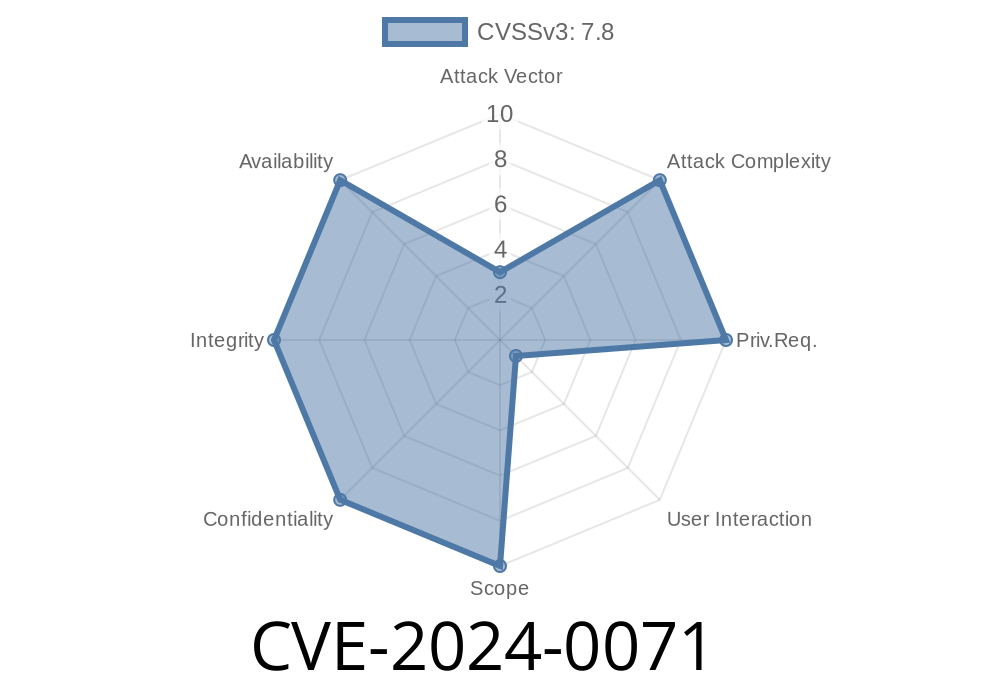In early 2024, cybersecurity researchers discovered a dangerous security hole in the NVIDIA GPU Display Driver for Windows. This flaw, tracked as CVE-2024-0071, exists in the user mode layer of the driver. If a regular, unprivileged user on a Windows machine exploits this vulnerability, they can write data outside of the boundaries the program expects (an "out-of-bounds write"). This can let attackers:
Gain higher permissions on your system
In this post, we'll break down CVE-2024-0071 in simple terms, show how an exploit works, and link you to trusted resources.
Where Is the Bug?
This vulnerability lives in the user mode layer of NVIDIA's display driver (nvlddmkm.sys for kernel, but vulnerable functions are exposed via user-mode libraries such as nvapi64.dll). The user mode layer interacts closely with applications and less with system-level protections, making it an easy target for attackers.
The core of the issue is that the driver doesn't properly check user input before using it to write data, leading to an out-of-bounds write. In other words, the program is tricked into overwriting areas of memory it shouldn't touch.
Impact: Remote code execution, local privilege escalation, data leak, system crash
Any Windows PC with an NVIDIA GPU and outdated drivers is at risk. Home users, gamers, and businesses alike.
How Could an Attacker Use This?
A malicious actor only needs to get a user to run some code on the target system (e.g., via a phishing email, infected game mod, or compromised website). This code talks to the NVIDIA driver through normal Windows APIs—no special privileges needed.
Example Exploit (Simplified)
Below is a pseudo code snippet that demonstrates how a basic exploit might work. The real attack code would be more complex, but this should illustrate the basic path:
#include <windows.h>
#include <nvapi.h> // hypothetical, simplified
int main(void) {
// Normally used for legit GPU requests; here, crafting a bad request.
NvU32 invalidBuffer[1024];
memset(invalidBuffer, x41, sizeof(invalidBuffer)); // Fill with 'A's
// Exploit assumes existence of a vulnerable API
// e.g., user supplies length / pointer unchecked.
NVSTATUS status = NvAPI_CustomVulnerableCall(
invalidBuffer, // Supply pointer to malicious buffer
xFFFFF // Deliberately huge length, triggers out-of-bounds write
);
if (status != NVAPI_OK) {
printf("Driver did NOT crash (try again with different parameters)\n");
} else {
printf("Driver crashed! Likely vulnerable.\n");
}
return ;
}
Disclaimer: The above sample is for educational purposes only! Do not exploit real systems.
Craft a malicious buffer (special data in memory)
2. Call the vulnerable function in the NVIDIA API, passing in your malicious buffer and a size value that's larger than the real buffer size
3. The driver tries to write too much data, going outside the buffer's intended area—possibly on top of security controls or system structures
Result: Crash, memory corruption, or control seized by attacker
With knowledge of the operating system's memory layout, an advanced hacker can tailor this to reliably run code or elevate their privileges.
Who Is Affected?
- All Windows PCs running NVIDIA GPUs with display drivers prior to the patched versions released in early 2024
- Affected product lines include GeForce (gaming GPUs), Quadro (pro GPUs), and Tesla (AI/server GPUs)
Check your driver version ([NVIDIA Control Panel → System Information]) and compare it to the security bulletin ([below](#official-advisory)).
Update your NVIDIA GPU drivers now:
Visit NVIDIA's official download page
Use strong endpoint security software
5. For IT admins: consider disabling or limiting access to the NVIDIA display driver service until patched system-wide
Official Advisory & References
- NVIDIA Security Bulletin (January 2024) *(Find CVE-2024-0071 in table)*
- NIST NVD CVE-2024-0071 entry
- Mitre CVE page
Final Advice
CVE-2024-0071 is the kind of flaw criminals and malware will race to include in their attacks. If you have an NVIDIA GPU and run Windows, update your drivers as soon as possible. System admins should patch all endpoints—and consider system scans to ensure no exploit activity occurred.
Staying aware of GPU driver vulnerabilities can save your machine from serious damage, data theft, or worse.
*This exclusive post is for educational and defensive cybersecurity purposes only. Do not attempt to exploit CVE-2024-0071 on systems you do not own or have permission to test.*
Timeline
Published on: 03/27/2024 22:15:07 UTC
